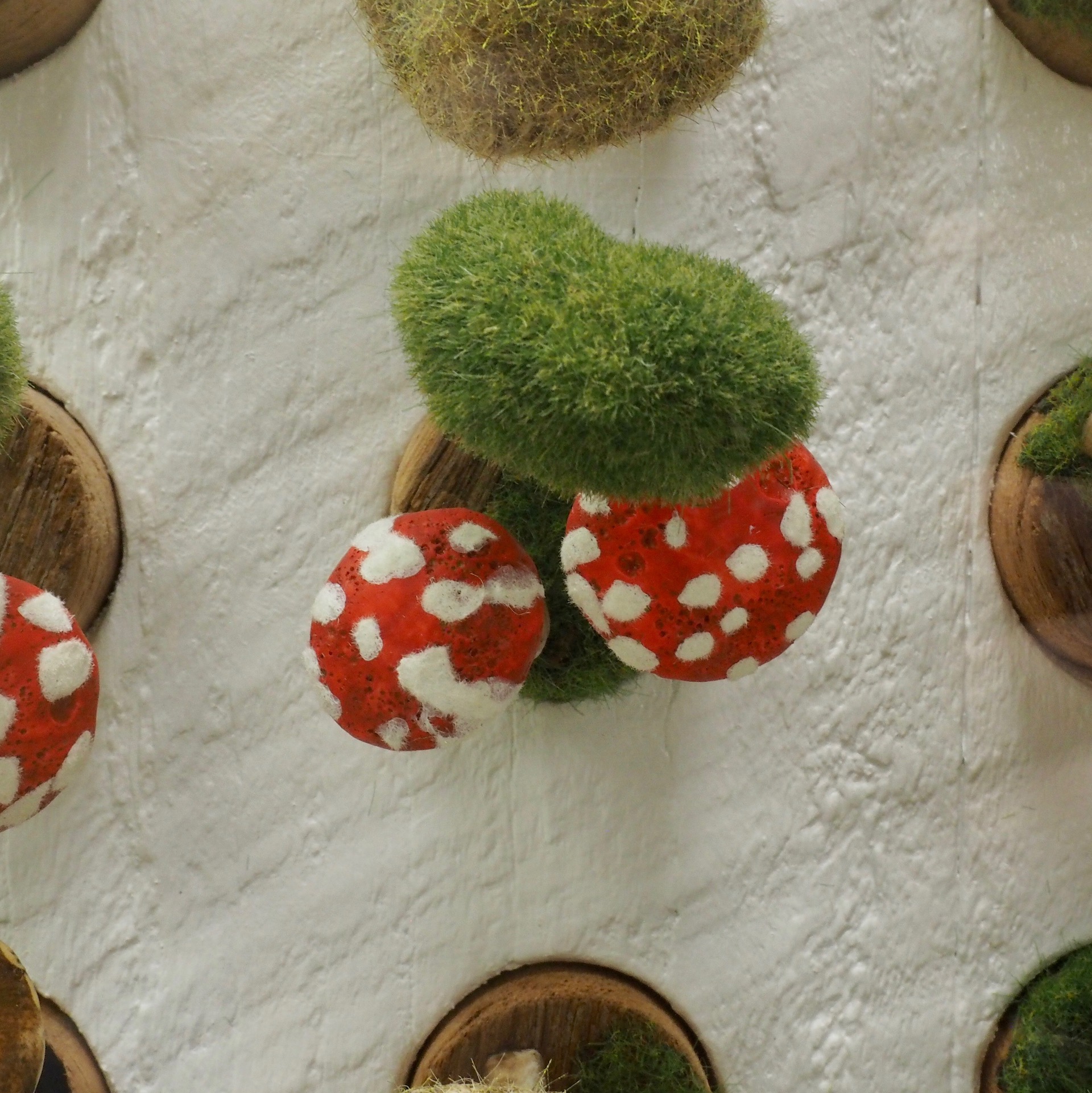
Mushrooms Plug Tray 100 (Detail)
Carved resin, faux grass and reclaimed barnwood, 2013
The Alfond Collection of Contemporary Art, Cornell Fine Arts Museum at Rollins College, Gift of Barbara ’68 and Theodore ’68 Alfond
2013.34.139
Recently, there has been an explosion of scholarship into the conservation of contemporary works of art. Historically a field limited to traditional art forms, with conservators painstakingly dissolving individual layers of varnish or carefully inpainting a damaged square centimeter of an oil portrait, art conservation has evolved into a flexible field restrained only by the material identity of the art object in question.
Although it may seem like an inversion of common sense, the degradation of newer works often eclipses that of more traditional forms of expression, such as oil paintings. This is partially due to the prevalent use of ephemeral, time-sensitive materials by contemporary artists, but it also stems from an expanded cultural acceptance of what actually qualifies as “art.”1 Today, art can literally be constructed using any material; selected works of interest from The Alfond Collection of Contemporary Art at the Cornell Fine Arts Museum (CFAM) use 16 mm polyester film, deer hide, and a commercial paper envelope. Sometimes, inevitable decay is unintended by the artist — an unfortunate side effect of the materials they chose. In other instances, the artist actively wishes for their work to degrade in the museum environment, challenging the museological duty of responsible preservation oftentimes ingrained in the mission statement of the holding institution.
As of 2013, with the opening of The Alfond Inn at Rollins College, CFAM acquired a growing collection of contemporary art objects. It now numbers almost 500 works, many of which utilize ephemeral materials not necessarily meant for fine art applications. Mushrooms Plug Tray 100 (2013) by Brian Burkhardt, a work from the inaugural selection of The Alfond Collection of Contemporary Art falls within this category. The work consists of one hundred individual cores of upcycled barnwood topped with exactly three mushrooms each. Burkhardt’s three hundred “mushrooms,” though, are not fungi at all. Rather, they are carved from synthetic resin, and they display a hyper-realistic level of detail. Some conform to the stereotypical vision of a mushroom: a red fungal cap spotted with white blotches. Others are coated with a layer of faux grass, likely the type of vinyl sheeting used in the construction of architectural dioramas and model train layouts. Some are even tinged blue, likely a whimsical reference by Burkhardt to the fact that many psilocybin-containing, hallucinogenic mushrooms bruise a bluish color when crushed.2

Mushrooms Plug Tray 100
Carved resin, faux grass and reclaimed barnwood, 2013
The Alfond Collection of Contemporary Art, Cornell Fine Arts Museum at Rollins College, Gift of Barbara ’68 and Theodore ’68 Alfond
2013.34.139
Image courtesy of the artist
Mushrooms Plug Tray 100 challenges material categorization in that it contains both organic (wood) and synthetic (resin, vinyl) elements. Thus, it parallels many ethnographic art objects in its use of composite media, a term which references the agglomeration of natural and artificial materials. Composite artworks and artifacts — such as wooden figures and masks adorned with brass tacks and glass beads from the Chokwe people of South Central Africa —have long tested the abilities of conservators at ethnographic art institutions.3 However, ethnographic art conservators have developed protocols aiming to stabilize the original materials of the artifact, thereby preventing further degradation while still retaining the authenticity of the material in question. Many of these techniques revolve around preventative conservation interventions, such as the application of protective surfactants or the construction of specialized, 3D-printed cushioning to prevent damage to the unique objects in storage or transit.
Art conservation — specifically contemporary art conservation — is now a more interdisciplinary field than ever. This environment requires contemporary art conservators to navigate an ever-changing sea of knowledge that borders multiple academic disciplines: among them art history, chemistry, and materials science. Hopefully, Mushrooms Plug Tray 100 will not generate any issues necessitating an art conservation intervention. However, if the work does begin to show signs of degradation, CFAM can look to the wealth of knowledge already assembled at ethnographic institutions regarding the conservation of composite objects for guidance.
References
1Linda Sandino, “Here Today, Gone Tomorrow: Transient Materiality in Contemporary Cultural Artefacts” (Journal of Design History 17, no. 3, 2004), 283-293. https://www.jstor.org/stable/3527118.
2Nicola Cunningham, “Hallucinogenic Plants of Abuse” (Emergency Medicine Australasia 20, 2008), 167-174. DOI: 10.1111/j.1742-6723.2008.01070.x.
3Stephanie E. Hornbeck, “Intersecting Conservation Approaches to Ethnographic and Contemporary Art: Ephemeral Art at the National Museum of African Art” (Objects Specialty Group Postprints 20, 2013), 207-226. http://resources.conservation-us.org/osgfiles/osg020-10.pdf.

